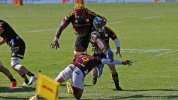You are using an out of date browser. It may not display this or other websites correctly.
You should upgrade or use an alternative browser.
You should upgrade or use an alternative browser.
Refereeing decisions
- Thread starter boyo
- Start date
If there are two balls on the field (that influence play) then I think you have to stop play and award a scrum to the team in possession which is what happened here.
Dan54
David Wilson (68)
Where does it say that? All I can find is the below:
A penalty try is awarded between the goal posts if foul play by the opposing team prevents a probable try from being scored, or scored in a more advantageous position. A player guilty of this must be cautioned and temporarily suspended or sent off. No conversion is attempted.
So while it was a professional foul, the very fact the Pom got the ball and was able to control it into touch, surely that means there was no guarantee of the Scotsman scoring. I am in no doubt its a yellow card, but can't see how it is a penalty try. Unless there is this mystery
I don't think there is the words professional foul in the law book either mate, but comes under foul play, and referees have to take player out of equasion for foul play, whether it is written or not I have no idea. Don't see how it not PT, if he did control it into touch with his hand it is foul play, you cannot throw a ball into touch. By doing so he prevented the Scot's player from catching it, same as anytime a player knocks ball forward on purpose. Had he knocked it backwards there maybe an argument he wasn't trying to knock it into touch, but there were 2 acts of foul play, purposeful knockon AND knocking into touch off hand.
Wilson
Tim Horan (67)
Yeah, I think it was probably the right call for the situation, though I wonder if the source of the second ball matters.If there are two balls on the field (that influence play) then I think you have to stop play and award a scrum to the team in possession which is what happened here.
Dan54
David Wilson (68)
Yep that was how SBW's case was ruled, the player was a couple of metres away if I remember, he could easily of just put hand on top of ball but chose to bat it dead, was ruled a PT as he had committed a foul act to prevent a probable try.This one is in the middle for me. I disagree with the concept of pretending the player that committed the foul play doesn't exist and what would have happened instead. In my view it creates more issues than it solves.
In this instance I think the penalty try is reasonable because you have to assume that the player took the action they did because they didn't see any other action as being possible. Obviously they could have tried to catch the ball with both hands above their head instead of batting it. The fact that they didn't has to be looked at as them doing it out of desperation rather than due to not knowing the laws.
I can't remember this one specifically but this is the sort of one where I think it is silly to assume that the player doesn't exist. Let's say there is a player in goal with the ball and the closest attacker is 20 metres away and there is no other teammate around. If the player with the ball throws it over the dead ball line rather than placing it down I really don't think it should be a penalty try because you assume they weren't there. That concept is ridiculous.
You're looking at whether a try would have been scored without the foul play and in that case no, it wouldn't have because there were lots of other options available to prevent a try (just that they were all by the player who committed the foul play).
"This was a press report;
Referee Angus Gardner reached into his pocket for a yellow card and the match officials confirmed a penalty try after watching video replays.
They ruled a Frenchman would have gathered Anthony Belleau's high kick and scored had Williams not got his big mitts in the way.
I thought Gardner was right there and (have never heard it argued as wrong ) and O'Keefe right in this case.
Pfitzy
Phil Waugh (73)
If there are two balls on the field (that influence play) then I think you have to stop play and award a scrum to the team in possession which is what happened here.
Yep. Usually it only happens at a stoppage so you can blow time off, but in live play if it will affect play, like passing it into the ref: scrum to attacking team.
Tomikin
Michael Lynagh (62)

Six Nations England v Scotland, 4Mins into extra time, 5th reset scrum in a row, how would you handle the pressure as a referee? In this video International Rugby Ref Dr. Ben O'Keeffe explain his… | Peter Breen
Six Nations England v Scotland, 4Mins into extra time, 5th reset scrum in a row, how would you handle the pressure as a referee? In this video International Rugby Ref Dr. Ben O'Keeffe explain his process when faced with this situation. Watch the full 60min video inside the Rugby Bricks Club...
 www.linkedin.com
www.linkedin.com
Pretty good insight from Dr Ben
waiopehu oldboy
Rocky Elsom (76)
Tomikin
Michael Lynagh (62)
Smiths not allowed to tackle him in the airThoughts on PGS hurdling ASmith?
View attachment 13058
Wonderfully athletic but surely dangerous or at least reckless.
waiopehu oldboy
Rocky Elsom (76)
The laws almost certainly need tightening up in this instance.
I agree that it is dangerous play but where does it end? If you just jump over and outstretched arm that is trying a grass cutter tackle or an ankle tap is that still dangerous play (it's not).
Likewise, we don't penalise an attempted high/dangerous tackle that misses (i.e. a player ducks under a tackle completely or a shoulder charge misses completely).
Maybe the law addition should be something like "it is illegal for the ball carrier to jump over the head or torso of a defender to avoid being tackled. - Sanction Penalty."
I agree that it is dangerous play but where does it end? If you just jump over and outstretched arm that is trying a grass cutter tackle or an ankle tap is that still dangerous play (it's not).
Likewise, we don't penalise an attempted high/dangerous tackle that misses (i.e. a player ducks under a tackle completely or a shoulder charge misses completely).
Maybe the law addition should be something like "it is illegal for the ball carrier to jump over the head or torso of a defender to avoid being tackled. - Sanction Penalty."
Wilson
Tim Horan (67)
I think the real problem here is the nature of the jump - hurdling over like that with a leg kicking out out presents a danger to the tackler and leaves the ball carrier at risk of being tipped accidentally in the tackle, whereas a dive over the player to the line has much less chance of going wrong.
Brumby Runner
George Gregan (70)
I think there was a try scored by one of the Aussie teams where a player picked the ball up and dove over the ruck to score. Would that also constitute dangerous play?
waiopehu oldboy
Rocky Elsom (76)
PhilClinton
Mark Ella (57)
I think there was a try scored by one of the Aussie teams where a player picked the ball up and dove over the ruck to score. Would that also constitute dangerous play?
Interesting point - the post below yours says hurdling has been banned now, which makes sense. But they also use an example of a try scored by the English last year where a player dives over another player in the act of diving at the try line, and they say that play is legal.
The clarification I think that needs to be made is whether the act of diving means the attacking players knees/feet could impact the shoulders/head of the defenders. So in the case of a player diving from the base of a ruck, over the defenders, in a mostly horizontal motion, I don't see the same level of danger as a genuine hurdle, so it should be play on.
liquor box
John Hipwell (52)
Nothing on the WR (World Rugby) site yet but reportedly they've issued a Law clarification to the effect that a ball carrier can't leap over an attempted tackle. Sanction is a PK.
Stuff
www.stuff.co.nz
If a kick is contested in the air then there is a tackle about to be made, is this jumping into a tackle?“We agree – jumping to hurdle a potential tackler is dangerous play, as is the act of a ball carrier jumping into a tackle,” the official statement read.
“Even if no contact is made, we believe this act is in clear contravention of law 9.11, and runs contrary to the game-wide focus on player welfare.
I don't have an issue with this part, but do find it odd that with a focus on player safety that you can allow a dangerous play as long as you are scoring a try.“In principle, in a try scoring situation, if the action is deemed to be a dive forward for a try, then it should be permitted.
waiopehu oldboy
Rocky Elsom (76)
No - there's no tackle for anyone to "jump into" until someone catches it.If a kick is contested in the air then there is a tackle about to be made, is this jumping into a tackle?
Brumby Runner
George Gregan (70)
Tackled without the ball? Reckon I've seen that penalised many times in games. Or is that just another misnomer imported from League?No - there's no tackle for anyone to "jump into" until someone catches it.
PhilClinton
Mark Ella (57)
I guess the thought process is the trajectory of the players body when in the motion of attempting to score a try won't be a dangerous position?I don't have an issue with this part, but do find it odd that with a focus on player safety that you can allow a dangerous play as long as you are scoring a try.

